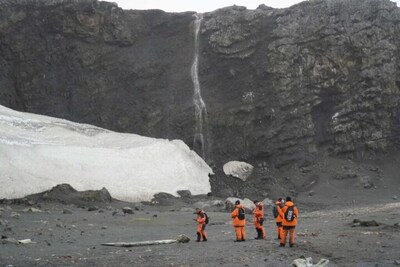Celestial Spectacle: Your Ultimate Guide to Catching the Lyrid Meteor Storm in 2025
Science
2025-04-21 12:01:48Content

Stargazers and astronomy enthusiasts, get ready for a celestial spectacle! The latest meteor shower, born from the remnants of a passing comet, is set to illuminate the night sky with a dazzling display of fireballs. Active for just over a week, this cosmic light show promises to be particularly intense during the overnight hours.
Astronomers predict an extraordinary visual feast as the comet's debris streaks across the darkness, creating brilliant, fleeting moments of celestial drama. Skywatchers are advised to find a dark, unobstructed location away from city lights to fully appreciate this natural wonder.
Whether you're a seasoned astronomer or a casual observer, tonight offers a rare opportunity to witness the breathtaking beauty of a meteor shower at its peak. Don't miss this chance to connect with the magnificent wonders of our universe!
Celestial Spectacle: The Lyrid Meteor Shower Illuminates the Night Sky
As the Earth traverses its annual cosmic journey, astronomy enthusiasts and casual stargazers alike are preparing for a breathtaking celestial display that promises to transform the darkness into a canvas of brilliant light and motion. The night sky is about to become a theater of natural wonder, inviting those who dare to look upward to witness a spectacular astronomical event that connects us to the vast, mysterious universe beyond our planet.Witness the Cosmic Dance: Nature's Most Spectacular Light Show Unfolds
The Origins of the Lyrid Meteor Shower
The Lyrid meteor shower emerges from the intricate cosmic debris left behind by Comet Thatcher, a celestial wanderer that periodically sweeps through our solar system. This annual astronomical phenomenon occurs when Earth's orbit intersects with the comet's ancient trail of dust and rock fragments. As these microscopic particles collide with our planet's atmosphere at tremendous velocities, they create stunning streaks of light that captivate observers and ignite the imagination of scientists and sky watchers alike. The scientific mechanism behind this spectacular event is rooted in the complex interactions between cosmic matter and planetary atmospheres. When these tiny fragments enter Earth's atmosphere at speeds exceeding 110,000 miles per hour, they undergo rapid heating and ionization, producing the brilliant luminous trails that we recognize as meteors or "shooting stars". Each fragment represents a miniature cosmic performance, burning brightly for mere moments before disappearing into the vast darkness.Peak Performance: Maximizing Meteor Viewing Opportunities
Astronomers and meteor enthusiasts recommend several strategic approaches to experiencing the most intense moments of the Lyrid meteor shower. The optimal viewing window typically occurs during the darkest hours before dawn, when the constellation Lyra is highest in the sky. Rural locations far from urban light pollution provide the most immersive and visually stunning experiences, allowing observers to witness potentially dozens of meteors per hour during the peak activity. Professional and amateur astronomers alike suggest preparing for extended observation periods by selecting comfortable outdoor viewing locations, utilizing reclining chairs or blankets, and allowing eyes to fully adjust to the darkness. Specialized equipment is unnecessary; the naked eye remains the most effective tool for capturing the full majesty of these celestial displays. Patience becomes a critical virtue, as meteor viewing requires a willingness to embrace the unpredictable nature of these cosmic events.Scientific Significance Beyond Visual Splendor
Beyond their aesthetic beauty, Lyrid meteor showers represent crucial opportunities for scientific research and understanding. Each meteor fragment carries potential insights into the composition of cometary bodies and the early formation of our solar system. Researchers utilize advanced tracking technologies and specialized cameras to capture detailed data about meteor trajectories, chemical compositions, and atmospheric interactions. The study of meteor showers contributes significantly to our comprehension of planetary dynamics, offering glimpses into the complex mechanisms that have shaped our cosmic neighborhood over billions of years. By analyzing the physical characteristics of these celestial visitors, scientists can reconstruct historical narratives about the evolution of planetary systems and the intricate dance of celestial bodies.Cultural and Historical Perspectives
Throughout human history, meteor showers have inspired mythology, artistic expression, and philosophical contemplation. Ancient civilizations interpreted these celestial events as divine messages or portents of significant transformations. From Native American traditions to Chinese astronomical records, meteor showers have consistently captured human imagination, representing moments of profound cosmic connection. Modern cultural interpretations continue to evolve, with contemporary society viewing these astronomical events through lenses of scientific curiosity and collective wonder. Social media platforms and digital communication technologies now enable global communities to share real-time experiences, transforming personal observations into collective moments of astronomical appreciation.RELATED NEWS
Science

Revolutionary 'Paper-Thin' Chip Breakthrough: Silicon's Days Might Be Numbered
2025-04-30 08:23:15
Science

Beef Tallow: The Controversial Health Trend That's Dividing Celebrities and Scientists
2025-03-17 17:09:02
Science

STEM Spectacular: Young Innovators Converge at Kentucky Science Center's Engineering Extravaganza
2025-02-24 01:00:00





